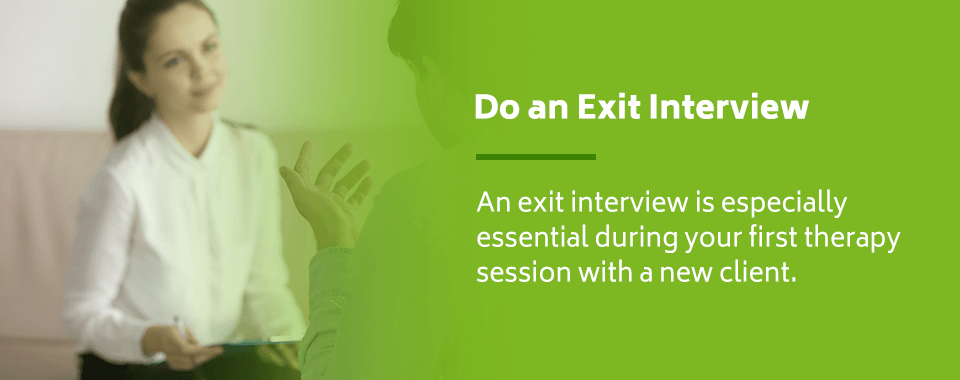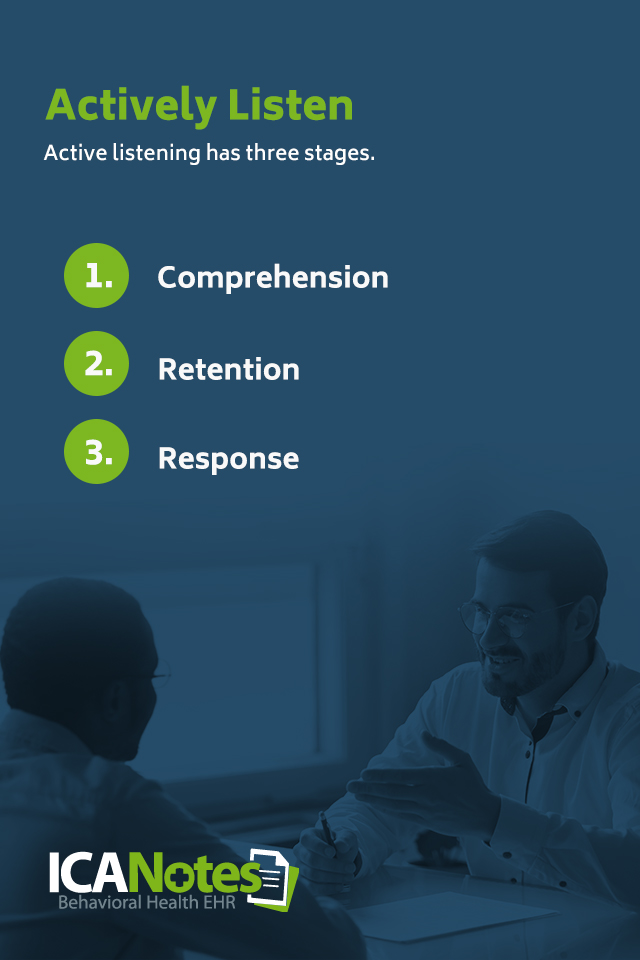How to Increase Client Communication
Effective communication is central to the client-therapist relationship. It's the underlying theory behind talk therapy. If you're having trouble getting through to a client or find that many of your clients end counseling prematurely, you might be wondering how to get a client to open up. Increasing client communication is about building trust and an open, honest relationship with your patients.
Know that establishing and nurturing the connections you have with your clients takes time. It starts with your first session and grows as you and your clients get to know one another. If you've hit a wall in your attempts to bond and communicate with your clients, there are several strategies you can try.
Table of Contents
- Ask Focused Questions
- Be Welcoming
- Build a Powerful Relationship
- Do an Exit Interview
- Actively Listen
- Stay in Touch
- Simplify Documentation With ICANotes
1. Ask Focused Questions
Even before your first session with a client, you have the chance to start asking the right questions. Most counselors use an intake form to get some basic questions answered. A lot of these questions are procedural, such as date of birth, medical history and history of mental illness. It's also a chance for you to see a broad range of symptoms.
Some common questions on an intake form ask patients to rate symptoms on a scale of one to five. You might also ask how frequently a client has experienced a problem in the past month. Intake forms can be helpful for you to get information the client might not think to share. For example, someone seeking therapy for depression might not realize how their relationships or their alcohol usage relate to their condition.
Before you begin the first session with a new client, review any initial information they provided. If you give clients intake forms a few days before the initial session, you can take some time to review it. You'll ask a lot of questions during the first session. The more informed your inquiries are, the more comfortable you can make your client feel.
A client might spend 10 or 20 minutes answering questions on a detailed intake form. If you repeat these same questions face to face, the client may feel as though you are wasting their time. Instead, use what information you have to ask for clarification. Give your client space to expand upon the answers they already gave. One great way to get some information about a client's concern is to ask, "What brings you in today? Why now and not three months ago?"
By asking specific, focused questions, you can uncover new nuggets of insight and encourage your clients to share. Pay attention to the kind of language they use. Know that the client relationship strengthens with time. Some people will only share surface-level information at first. If the questions you ask aren't working, try rephrasing or asking different ones.
As your relationship with your client grows, you can use questions to prompt further conversation. Here are some ideas.
- How have you been since we last met? What have you been doing? If the client had discussed upcoming plans, ask about how things went.
- How has your mood been, on a scale of one to 10?
- If a loved one approached you with this same problem, what would you say to them?
2. Be Welcoming
Especially in an initial session, therapy can feel a bit clinical or even business-like. Your personality, to a certain degree, adds warmth, comfort and familiarity to the process. You must adjust your communication style to reflect your client's preferred habits. Some call this strategy being like a "tuning fork." The idea is to speak in your client's language and, at the same time, help them center themselves.
For example, for anxious, quiet clients, adopt a calm and collected approach. With a tone of reserved confidence, you can encourage the patient to come out of their shell without being intimidating. For a hyperactive client, take on an energized disposition while staying at ease. On the one hand, you want to mirror the client's personality. On the other, you want to encourage them to relax more. Studies have shown that when clients and psychotherapists have similar personalities, it leads to better symptom reduction after therapy ends.
Being more welcoming can also be about the environment you create. Set the thermostat to a comfortable temperature and use a white noise machine to establish privacy. Provide some comforts throughout the office, such as tissues and soft pillows. Tailor the environment to the patient you are seeing. For example, if you are working with a child, consider a few small toys or a coloring book. For older clients, try stress balls and soothing decor, such as plants and artwork.
3. Build a Powerful Relationship
The success of your clients' time in therapy is, in part, due to the strength of your therapeutic alliance. Research has shown that the quality of the client-therapist partnership is an indicator of a favorable clinical outcome. What is the client-therapist alliance, exactly? You might see it called the therapeutic alliance or the client-therapist relationship. According to psychologist Carl Rogers, successful counseling relies on a robust bond between therapist and client. The therapeutic alliance is a combination of three dimensions.
- Agreement between client and therapist on goals
- Collaboration on therapy-related tasks
- Emotional bonding
You might carefully plan which techniques will work best for a particular client. As you are doing so, remember that your client needs a human connection first. You cannot bluff your way to a strong emotional relationship. You need to feel real empathy and display a genuinely positive attitude. Your clients will sense any falsehoods and become closed off.
So, how else can you build rapport with clients? Talking about something seemingly off-topic is one strategy that can have a positive effect. When you discuss something outside the realm of your clients' problems, you show you care for them as people. These unrelated discussions have genuine emotional weight and meaning to your clients. By paying them the right amount of attention, you can even discover some surprising breakthroughs.
Here are a few other tips you can try to strengthen communication and bonds with clients.
- Be patient: Know that some people will be uncomfortable with sharing. They may feel anxious talking about themselves or letting a stranger into their worlds. Wait to discuss more sensitive topics. As your relationship progresses and clients feel safer, they will begin to open up.
- Start small: One way to show clients they can trust you is to guide them toward a small solution right off the bat. Words of encouragement, positive feedback or some helpful tips can prove your expertise. Your client might become more confident in your ability to help them after they see your advice on a small matter pan out.
- Find your "in": Learn from your client's interests, dislikes, worldviews and strong suits. If you can talk to someone on their level and appeal to a client's pride, principles or talent, ideas start to click. A tactic such as using a metaphor related to clients' interests can show that you pay attention to them and make an effort to understand their worlds.
4. Do an Exit Interview
An exit interview is especially essential during your first therapy session with a new client. You and your client both need to feel confident that you will be able to work toward positive outcomes. If your client feels uneasiness around you, they may not be able to have a productive therapeutic relationship with you. You might also have difficulties if you have mismatched personalities.
The corporate world uses exit interviews to learn more about employees' experiences as they leave a company. Schools also use them with graduating students. These interviews reveal what is valuable and provide feedback on areas for improvement. In therapy, you can use exit interviews to understand if the client thinks you are a good match for them. Here are some questions you can ask.
- Do you feel comfortable working with me?
- Am I setting the right tone for you?
- Based on what I've described to you so far, do you feel confident we can make progress together?
The exit interview is also your chance to inform a client if you can't help. If the client's issues aren't within your area of expertise, you can recommend a counselor who has the right experience. By being honest with a client and giving them new resources, you can ease feelings of rejection. If the exit interview reveals the client doesn't feel able to work with you, feel free to recommend other counselors and resources.
As you dive into new sessions, it can be helpful to conclude each with an informal exit interview. Each client is unique and may prefer some of your techniques over others. Asking questions can help you get a sense of what works for your client and what doesn't. If you try a few different strategies with a client or suggest an item of homework, follow up at the end of the session.
For example, if you recommended meditation, check in with the client by asking, "How did you like meditating? Did you find it relaxing, or was it uncomfortable?" If you had them work on something before your next session, ask something like, "On a scale of one to 10, how likely are you to do this again in the future?" If the answer is low, use this as a chance to adjust the task.
How you end a therapy session can be vital to developing the client-therapist relationship. Alongside an exit interview, a graceful exit strategy can be central to success. Letting a client know when there are only a few more minutes left of a session can help. Many therapists use the last few minutes to do a quick summary of the session. You can also discuss any preparations for the next meeting, such as homework or the client's upcoming plans.
5. Actively Listen
Active listening is essential for any client relationship, especially for one where the client is nervous about opening up. Engaged listening validates a speaker's thoughts and ideas by showing the person that their words are worth paying attention to.
Active listening has three stages.
- Comprehension: First, you must actively hear and analyze what the speaker says. You cannot get distracted or start thinking about other things.
- Retention: You should remember what people tell you. As a counselor seeing many patients, often with a week or two in between sessions, this can be challenging. You can try taking some notes or using memory tricks. When you can recall specific details about a client from week to week, it can help build rapport with the client and make them feel understood.
- Response: You should provide verbal and nonverbal feedback to show you are both hearing and understanding what the speaker is saying.
Here are a few ways to show active listening:
- Summarize what the client says and repeat it to them.
- Ask clarifying questions when a client tells a story.
- Make eye contact and use body language such as nodding, smiling and leaning forward.
- Use small verbal cues such as "tell me more" and "I see."
- Discuss the emotions the speaker is conveying — for example, "If I understand you correctly, you're feeling both guilty and angry right now. Is that right?"
6. Stay in Touch
Making the client feel connected to the therapeutic relationship can be crucial. With sessions sometimes a week or two apart, you want your clients to feel like they have resources to help them through a tough time. Consider giving your clients an email or a phone number where they can reach you. Let them know they can get in touch with you if something comes up. Most clients will appreciate the gesture and will not abuse the privilege. You can also provide them with some resources to turn to on their own, such as a mental health blog or a support group.
Another way to encourage your clients to stay in touch is to have them follow your social media and email newsletters. A digital presence gives your clients a way to feel connected with you throughout their daily life. If you encourage clients to follow your social media pages or email blasts, it's crucial to remain active and involved online. Post articles, relaxation tips, grounding exercises and other resources that will be helpful to your clients.
Simplify Documentation With ICANotes
As a behavioral health professional, you spend much of your time building strong relationships with your clients. ICANotes lets you focus on your patients as people. Our automated system develops reliable documentation with detailed and individualized mental health records. You can minimize your medical-legal risk and keep your notes organized between sessions, all without typing or dictating. Our system also includes many practice management features, such as scheduling, billing and reporting.
Psychologists, clinical social workers, counselors and therapists can all take advantage of our intuitive software to make documentation fast and straightforward. We save you time so you can focus on helping your clients. Learn about the robust features we offer mental health professionals like you. Want to get started? Sign up for a free live demo or a complimentary trial today.
Related Posts
How to Make Progress With Your Clients in Their Treatment Plans
What You Need to Know About EHRs and Patient Privacy
What Is Evidence-Based Health Care?
How to Bill for Longer Couples & Family Therapy Sessions
Tips for Having a Successful Teletherapy Appointment





